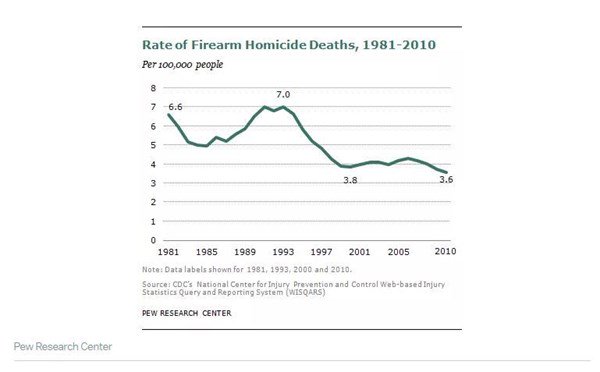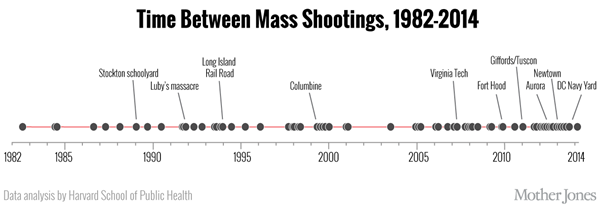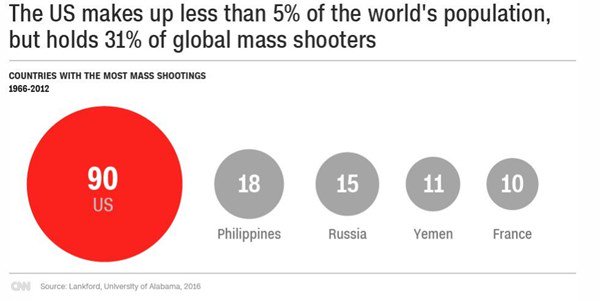
If you asked me this morning which nation has the most mass shootings in the world, I would have said, with perhaps a flicker of hesitation, the United States.
This is a tad embarrassing to admit because I’m pretty familiar with shooting statistics, having written several articles on gun violence and the Second Amendment. Below is a basic overview of gun violence in America. While gun homicides have been
steadily declining for decades in the US, mass shootings have indeed been trending
upward.


This fact alone probably would not have led me to believe that the US leads the world in mass shootings, however. An assist goes to the US media and politicians.
The Dominant Narrative
"Let's be clear,” President Obama
said in 2015 after a shooting in North Carolina. “At some point, we as a country will have to reckon with the fact that this type of mass violence does not happen in other advanced countries."
Sen. Harry Reid
echoed this sentiment. "The United States is the only advanced country where this kind of mass violence occurs.”
Media headlines have left little doubt that the US
leads the world in mass shootings. In fact,
according to CNN, it isn’t even close.

The comments and data seem to conclusively say that the US leads the world in mass shootings and the violence is unique, a product of “
America’s gun culture.”
It’s a slam dunk case except for one thing: it’s not true.
The Root of the Myth
Statistics on global mass shooting incidents from 2009 to 2015 compiled by economist John Lott of the Crime Prevention Research Center
show that the US trails many other advanced nations in mass shooting frequency and death rate.


As
Investor’s Business Daily noted on these findings, “Yes, the U.S. rate is still high, and nothing to be proud of. But it's not the highest in the developed world. Not by a long shot.”
If this is true, how did the narrative that the US leads the world in mass shootings become the conventional wisdom? The myth, it turns out, stems from University of Alabama associate professor Adam Lankford.
Lankford’s name pops up in
a montage of media reports which cite his research as evidence that America leads the world in mass shootings. The violence, Lankford said, stems from the high rate of gun ownership in America.
“The difference between us and other countries, [which] explains why we have more of these attackers, was the firearm ownership rate,” Lankford
said. “In other words: firearms per capita. We have almost double the firearm ownership rate of any other country.”
Lankford’s
findings show that there were 90 mass public shooters in America since 1966, the most in the world, which had a total of 202. But Lott, using Lankford’s definition of a mass shooting—“four or more people killed”—found more than 3,000 such shootings, John Stossel recently
reported.
When findings do not mesh, scholars, in pursuit of truth, generally compare notes, data, and methodology to find out how they reached their conclusions. After all, who is to say Lankford doesn’t have it right and Lott is wrong? There’s just one problem: Lankford isn’t talking.
Lankford refuses to explain his data to anyone—to Stossel, to Lott, to the
Washington Post, and apparently
anyone else who comes asking, including this writer. (I emailed Lankford inquiring about his research. He declined to discuss his methodology, but said he would be publishing more information about mass shooting data in the future.)
“That’s academic malpractice,” Lott tells Stossel.
Indeed it is. Yet, it doesn’t explain how one professor’s research was so rapidly disseminated that its erroneous claim quickly became the conventional wisdom in a country with 330 million people.
Truth versus Narrative
For that, we must look to the era of narrative-driven journalism and the politicization of society, both of which subjugate truth to ideology and politics. Media and politicians latched onto Lankford’s findings in droves because his findings were convenient, not because they were true.
This is an unsettling and ill omen for liberty. As Lawrence Reed has
observed, the road to authoritarianism is paved with a “careless, cavalier, and subjective attitude toward truth.” Yet that is precisely what we see with increasing frequency in mass media. (Need I reference
the Covington debacle and
the Smollet hoax?)
More than a hundred years ago Mark Twain noted, "A lie can travel halfway around the world while the truth is putting on its shoes."
Twain’s quote remains true even in the age of the internet. Lankford’s erroneous research had free rein for two years and was disseminated to tens of millions of viewers and readers before the truth finally got its shoes on.
If you ask most Americans today which country leads the world in mass shootings, I suspect a vast majority would say the US. And there’s always a price for the erosion of truth.
Jonathan Miltimore is the Managing Editor of FEE.org. His writing/reporting has
appeared in TIME magazine, The Wall Street Journal, CNN, Forbes, Fox News, and the Washington Times.
Reach him at jmiltimore@FEE.org.
This article was originally published on FEE.org. Read the original article.








 processed October 1958
processed October 1958 processed September 1960
processed September 1960 processed September 1960
processed September 1960 processed September 1959
processed September 1959






 Sgt. Turner? photographing the wedding, 2/22/58
Sgt. Turner? photographing the wedding, 2/22/58 Reception line at chapel, 2/22/58
Reception line at chapel, 2/22/58 Del & Mrs. Potter, Sr., 2/22/58
Del & Mrs. Potter, Sr., 2/22/58 Wind River Canyon, 2/21/58
Wind River Canyon, 2/21/58

 September 1967
September 1967 Larry Laffron? - April 1967
Larry Laffron? - April 1967 April 1966
April 1966 June 1968
June 1968

 June 1963
June 1963 June 1963
June 1963 Forum At Pompei - May 1959
Forum At Pompei - May 1959 September 1960
September 1960









